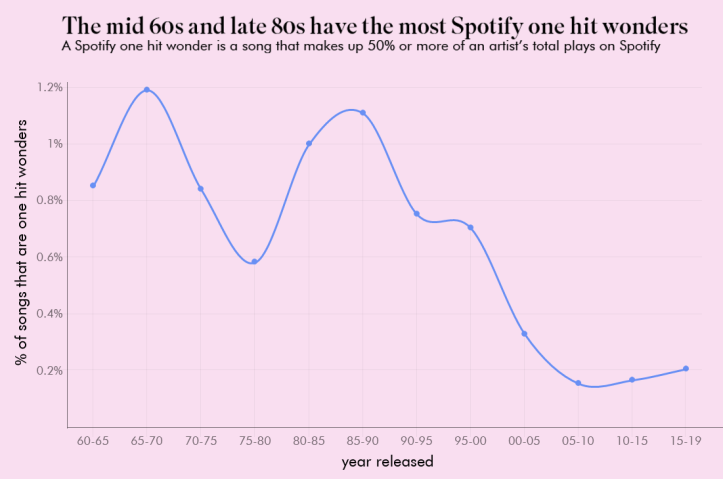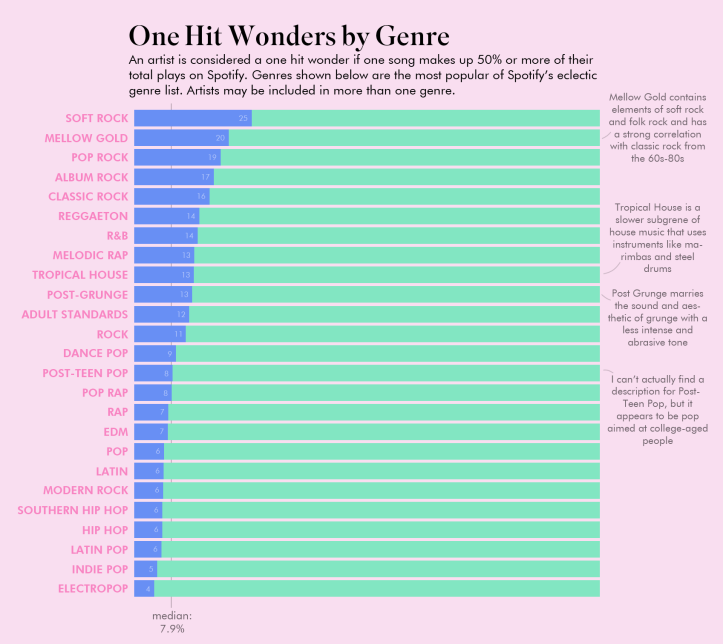Most one-hit wonder analyses focus on the time the song spent on the charts, and whether the artist ever charted again. For this analysis, I was interested in something a bit different–what are the biggest one hit wonders as defined by current listening data? In other words, what songs make up the highest percentage of an artist’s total plays on a streaming service like Spotify?
Data Gathering
I chose Spotify because I’m familiar with the API and the service, and because of the really excellent SpotifyR R package, which made all the data gathering programmatically trivial.
To get started, I needed a comprehensive list of artists on Spotify. I gathered this from two main sources.
First, I downloaded this list of approximately 80,000 artists from Kaggle. It was a pretty good start, but a quick ctrl+F showed that it was missing quite a few artists I thought of off the top of my head. To fill in these gaps, I used the Spotify API to gather the top 20 related artists for each artist on the list. After removing duplicates, I had about 180,000 records, and all the artists I could think of were represented in the dataset.
To cover all my bases, though, I manually gathered a list of about 20 “One Hit Wonder” playlists from the Spotify UI. I took each artist from these playlists, and found their top 20 related artists. Then, for each of those artists, I found the top 20 related artists, and so on for 5 rounds. This left me with a list of 5000-odd records, of which only a couple dozen weren’t in my first batch of records derived from Kaggle.
My final data set was well over 180,000 records, but I brought it down to about 40,000 by removing artists with fewer than 1000 total followers.
Next, I had to get listening data for every song by every artist on my list. Spotify doesn’t provide this, but a hero on Github put together an API to cull play counts from the Spotify desktop client. I was able to use this to gather listening data for over 7 million songs!
What is a Spotify one hit wonder?
For all the following analyses, I chose to only look at artists with more than 100 million total plays. This is absolutely an arbitrary cut-off, but it a) left me with a more manageable dataset of only 5800 artists, and b) insured that each artist was truly popular, ie, a hit.
I then defined a one hit wonder as a song that makes up 50% or more of an artist’s total Spotify plays. Again, this is an arbitrary cutoff, but I believe it’s a valid one: it means that this one song is more popular than the rest of the artist’s catalog, combined.
What year had the most one hit wonders?
Using my definition, I could calculate the percentage of songs each year that qualified as Spotify one hit wonders and plot it over time.

The 60s and the 80s proved to be the biggest decades for Spotify one hit wonders. This absolutely jibes with my gut feeling, but interestingly doesn’t align with this Billboard analysis by Todd Kerpelman, which found that the 80s actually had the least one hit wonders (as judged by a more traditional definition: an artist with one song in the Billboard top 25, but no other songs in the top 75.)
My best guess for this discrepancy is, more or less, the passage of time. My chart represents recent listening data, whereas the Billboard represents data for when the song was newly released. Perhaps the idea that the 80s had a lot of one hit wonders has stuck in our collective consciousness, and we only bother to listen to the tracks we remember as hits instead of exploring the rest of the artist’s catalog.
This explanation isn’t totally satisfying for me, though–I’d expect the mid-late 70s to have lots of Spotify one hit wonders as well if we were only listening to the hits.
Granted, all years prior to 2000 have quite a lot more Spotify one hit wonders than the years after. Do we just collectively forget about less popular songs after 20 years?
This seems like an interesting avenue of exploration, but I’m frankly not sure how to even get started without data about individual listeners.
What genre has the most one hit wonders?
Spotify is well know for its huge, eclectic list of very, very specific genres. In order to see which genre has the most one hit wonders, I limited this list to just the top 25 most popular, as defined by Every Noise at Once. Otherwise, I found, there were far too many obscure genres I struggled to define or even understand.

About 8% of the median genre’s artists can be considered Spotify one hit wonders. Unsurprisingly, soft rock and soft rock-adjacent genres top the list: a full quarter of artists have one song that makes up more than half their plays! This seemed incredible to me, and I had to double check the data, but the conclusion held.
What is the biggest one hit wonder on Spotify?
To clarify, by biggest I mean the one song that makes up the highest percentage of the artist’s total plays (where that artist has at least 100 million total plays).
Gathering the top one hit wonders was a bit more complicated than I expected. Spotify seems to show the same number of plays for the same song covered by different artists. For example, a DJ called Lea in the Mix remixed the EDM hit Tsunami, and was credited with 152 million plays for it, far more than any of his other songs:

However, the original version of Tsunami by DVBBS and Borgeous has the exact same number of plays:

I made a judgement call and decided that this is a flaw in Spotify’s data, and that poor Lea in the Mix didn’t actually deserve to be credited with the 152 million plays.
I had to go through and weed out quite a number of these false attributions to arrive at my list of the top 25 one hit wonders, but I eventually arrived at my final list. I made a playlist on Spotify for you to conveniently listen to any of these fine tracks:

Nobody I showed this to was surprised that Norman Greenbaum topped the list.
What surprised me, though, was not so much the top artists but, rather, the artists that didn’t make the top. Most notably, I had no idea that Lil Nas X had released anything other than Old Town Road–or that if he had, that anybody had bothered to listen to it. Similarly, I didn’t realize that a-Ha isn’t actually a one hit wonder, a fact also mentioned in Todd Kerpelman’s analysis.
Overall, I had a lot of fun with this project. It wasn’t analytically complex, but it was operationally difficult to pull all the data. I also enjoyed throwing together very simple visualizations in a fun, poppy color palette that reflects the simple, fun, poppy nature of most of these one hit wonders.
I wonder if there is some relationship to songs that are featured heavily in compilations, playlists, and soundtracks. For example, I think a lot of these show up in the Guardians of the Galaxy soundtrack. That would produce hits for just a narrow set of songs. It might also create positive feedback where those songs end up in compilations purely because they are so popular already. Cool thought provoking assessment!
LikeLike
How did you deal with different versions of the same song? Remixes, movie soundtrack versions, etc?
LikeLike
Have you accounted for the various version of “Take On Me” done by “a-Ha” ?
After quick search, the hit song is featured on at least 200 albums. I have no way of checking the number but I would imagine that most of them count towarf the original song play number because they’re identical.
But there are several version that are very similar but different for copyright purposes.
LikeLike
Interesting way to look at 1 hit wonders.
Would Dancing in the Moonlight be credited to King Harvest or Toploader on the list? Curious to know who has more plays?
Thanks!
LikeLike
I was looking at the artist page of Band Aid, and it seems that “Do They Know It’s Christmas?” is their only song. It has been listened to more than 300 million times and makes the band the 169th most listened one in the world. Would they also be considered a one hit wonder?
LikeLike
Interesting! They definitely would. I only included artists with at least 10 songs (roughly a whole album), so that’s why they don’t appear here
LikeLike
[…] visualization artist Erin Davis (erdavis.com) crunched the numbers to find the biggest one-hit wonders on Spotify. In order to find these big […]
LikeLike
[…] visualization artist Erin Davis (erdavis.com) crunched the numbers to find the biggest one-hit wonders on Spotify. In order to find these big […]
LikeLike
[…] visualization artist Erin Davis (erdavis.com) crunched the numbers to find the biggest one-hit wonders on Spotify. In order to find these big […]
LikeLike
[…] visualization artist Erin Davis (erdavis.com) crunched the numbers to find the biggest one-hit wonders on Spotify. In order to find these big […]
LikeLike